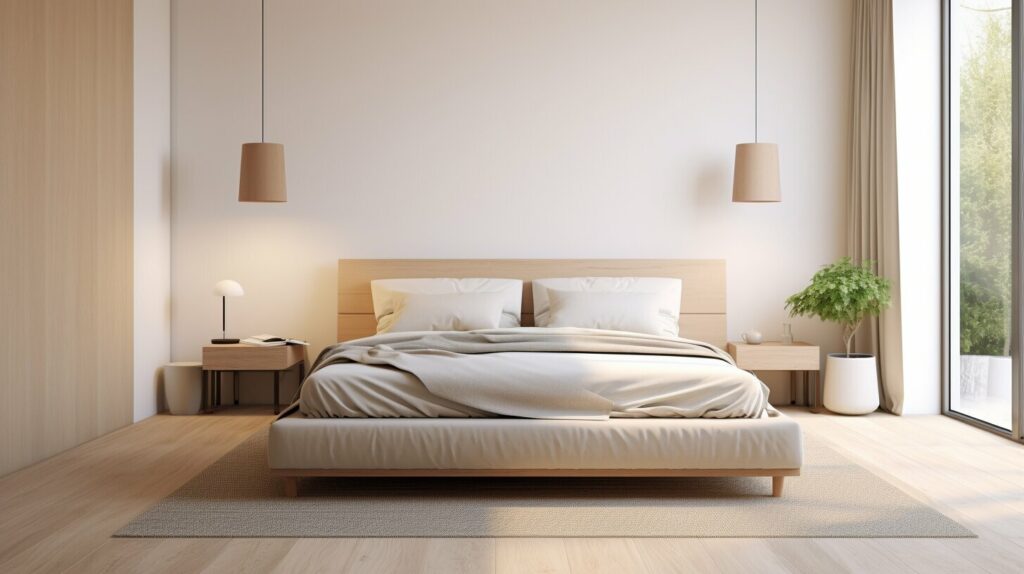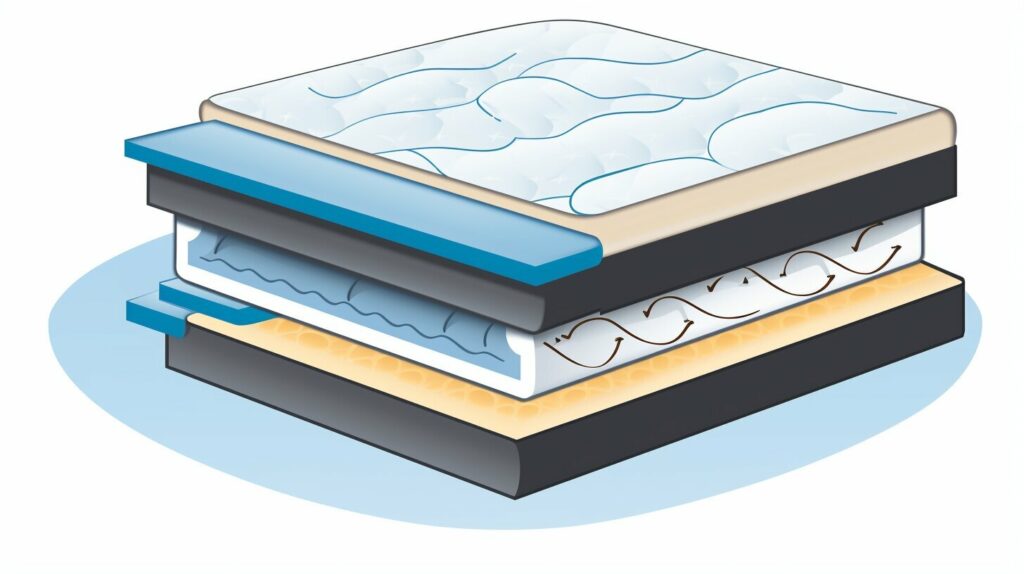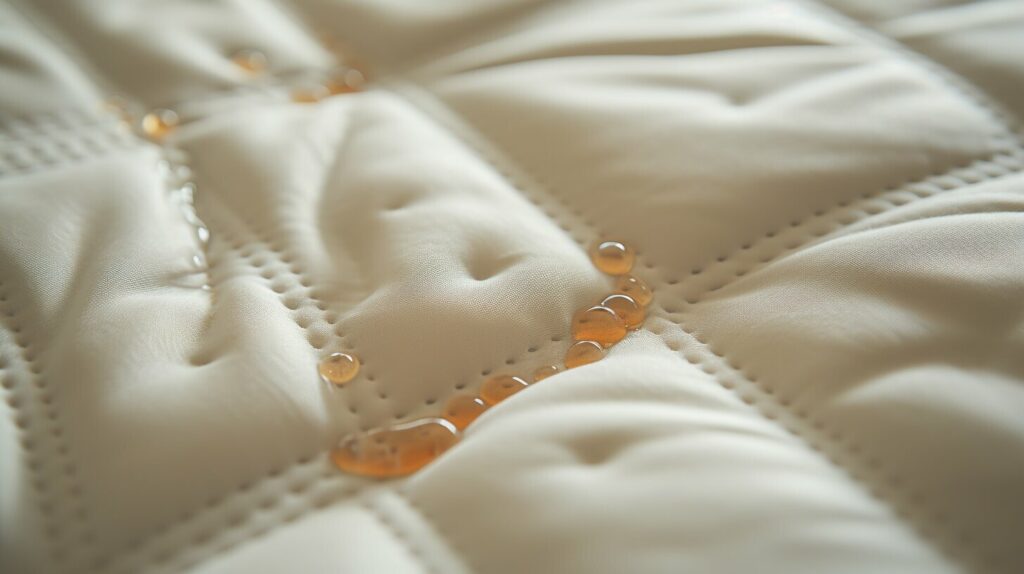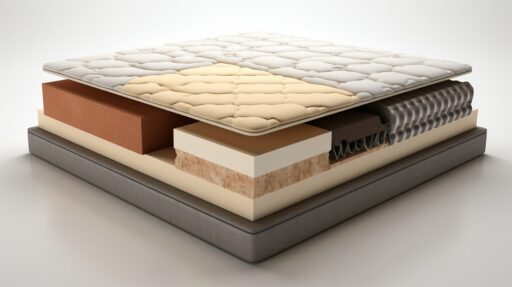Memory Foam vs. Latex vs. Innerspring: Which Mattress is Best?

When it comes to choosing the right mattress, the options can seem overwhelming. Should you go for memory foam, latex, or innerspring? We’re here to help you make an informed decision.
When choosing a mattress, it can be overwhelming to decide between memory foam, latex, and innerspring options. Innerspring mattresses use metal coils to provide support and have a firmer feel, while latex mattresses are made with high-density foam and offer body-contouring abilities and durability. The average price of an innerspring mattress is around $500-$1,800, while the average price of a latex mattress is $1,300-$3,000. Latex mattresses are known for their increased airflow, breathability, and hypoallergenic properties. However, they can be more expensive and less supportive for individuals with back pain. On the other hand, innerspring mattresses are more affordable and offer better edge support but have a shorter lifespan and lower motion isolation. Sleep position also plays a role in choosing the right mattress, with back sleepers and stomach sleepers generally preferring innerspring mattresses, while side sleepers can benefit from the contouring support of latex foam. It’s also important to consider other mattress options such as memory foam and hybrid mattresses. Memory foam offers a plush feel and the ability to relieve pressure points, while hybrid mattresses combine the best features of innerspring and foam mattresses. Ultimately, the choice between memory foam, latex, and innerspring mattresses depends on personal preferences and individual needs.

Key Takeaways:
- Memory foam, latex, and innerspring are the three main types of mattresses to consider when choosing the right mattress for your individual needs.
- Innerspring mattresses offer firm support and are more affordable, but have a shorter lifespan and lower motion isolation.
- Latex mattresses provide body-contouring abilities, durability, and increased airflow, but can be more expensive and less supportive for individuals with back pain.
- Sleep position plays a role in mattress choice, with back and stomach sleepers often preferring innerspring mattresses, and side sleepers benefiting from the contouring support of latex foam.
- Other options, such as memory foam and hybrid mattresses, offer unique benefits, such as pressure relief and a combination of innerspring and foam features.
Understanding Innerspring Mattresses
Innerspring mattresses are a popular choice due to their use of metal coils, which provide support and a firmer feel. These coils are typically made from steel and are strategically placed throughout the mattress to promote proper spinal alignment and reduce pressure points. The number of coils can vary depending on the mattress size and brand, with higher coil counts often associated with better support and durability.
One of the advantages of innerspring mattresses is their ability to provide a responsive surface that quickly adjusts to your movements. This makes them a great choice for combination sleepers or those who tend to shift positions throughout the night. In addition, the firmer feel of an innerspring mattress can be beneficial for individuals who prefer a more supportive sleep surface, especially those with back pain.
However, it’s important to note that innerspring mattresses do have some limitations. For example, they may not offer the same level of contouring and pressure relief as memory foam or latex mattresses. Additionally, the steel coils can create more motion transfer, potentially disturbing a sleeping partner when you move during the night. To minimize this, some manufacturers include features like pocketed coils, which are individually wrapped and can help isolate motion.
| Pros | Cons |
|---|
| Excellent support and durability | Less contouring and pressure relief |
| Responsive surface for easy movement | Potential for more motion transfer |
| Wide range of firmness options | May have a shorter lifespan compared to other mattress types |
When shopping for an innerspring mattress, it’s important to consider factors such as coil count, gauge (thickness) of the coils, and the quality of the materials used. Higher coil counts and lower gauge numbers generally indicate better quality and support. Additionally, pay attention to the comfort layers on top of the coils, as these can vary in materials and thickness, contributing to the overall feel of the mattress.
Remember, choosing the right mattress ultimately depends on your individual preferences and needs. While innerspring mattresses offer excellent support and durability, they may not provide the same level of contouring and pressure relief as other mattress types. By understanding the features and benefits of innerspring mattresses, you can make an informed decision that will help you achieve a comfortable and restful night’s sleep.
Exploring Latex Mattresses
Latex mattresses, made with high-density foam, offer excellent body contouring, durability, and hypoallergenic benefits. These mattresses are designed to conform to your body’s natural curves, providing optimal support and pressure relief. The high-density foam used in latex mattresses ensures long-lasting durability, making them a great investment for those seeking a mattress that will stand the test of time.
In addition to their durability, latex mattresses are also hypoallergenic, making them an ideal choice for individuals with allergies or sensitivities. The natural properties of latex help to resist dust mites, mold, and other allergens, creating a healthier sleep environment. This feature is particularly beneficial for those with asthma or respiratory issues.
Furthermore, latex mattresses offer excellent breathability and airflow. The open-cell structure of latex foam allows for enhanced ventilation, helping to regulate body temperature throughout the night. This can be especially beneficial for individuals who tend to sleep hot or experience night sweats.
To summarize, latex mattresses provide exceptional body contouring, durability, and hypoallergenic benefits. Their high-density foam construction ensures superior support and pressure relief, while their natural properties resist allergens and promote airflow for a cooler sleep experience. If you value comfort, longevity, and a healthy sleep environment, a latex mattress may be the perfect choice for you.

| Features | Benefits |
|---|
| Body Contouring | Provides optimal support and pressure relief |
| Durability | Long-lasting construction for years of use |
| Hypoallergenic | Resists allergens such as dust mites and mold |
| Breathability | Enhanced airflow for a cooler sleep experience |
Factors to Consider: Price and Lifespan
When considering your mattress options, it’s important to factor in the average price range and lifespan of innerspring and latex mattresses. Innerspring mattresses typically range in price from $500 to $1,800, making them a more affordable choice for budget-conscious shoppers. On the other hand, latex mattresses tend to have a higher price range of $1,300 to $3,000. It’s important to note that these prices can vary depending on the brand, model, and additional features.
In terms of lifespan, innerspring mattresses generally have a shorter lifespan compared to latex mattresses. On average, an innerspring mattress can last for about 7 to 8 years before it starts to lose its support and comfort. In contrast, a latex mattress can last for 10 to 12 years or even longer with proper care and maintenance. Keep in mind that these are just average estimates, and the actual lifespan of a mattress can vary based on usage, quality, and individual factors.
It’s essential to consider both the price and lifespan when making your decision. While innerspring mattresses may have a lower upfront cost, they may require more frequent replacement, resulting in additional long-term expenses. On the other hand, latex mattresses may have a higher initial investment, but their longer lifespan can provide better value over time.
Price and Lifespan Comparison
| Mattress Type | Average Price Range | Lifespan |
|---|
| Innerspring | $500 – $1,800 | 7-8 years |
| Latex | $1,300 – $3,000 | 10-12 years or longer |
Ultimately, when deciding between innerspring and latex mattresses, it’s essential to consider your budget, desired lifespan, and personal preferences for comfort and support. By carefully evaluating these factors, you can make an informed decision that aligns with your individual needs and provides you with a restful night’s sleep for years to come.

Your sleep position can greatly impact the type of mattress that suits you best. Back sleepers, stomach sleepers, and side sleepers all have different mattress preferences. Let’s explore which mattress type works best for each sleep position.
Back Sleepers
If you tend to sleep on your back, you’ll want a mattress that provides proper support to maintain the natural alignment of your spine. Innerspring mattresses are often a popular choice for back sleepers because they offer a firmer feel, which helps to keep the spine in a neutral position. Look for a mattress with a medium to firm level of support to ensure proper spinal alignment and prevent any lower back pain.
Stomach Sleepers
For those who prefer sleeping on their stomach, a mattress with medium-firm to firm support is recommended. Stomach sleepers need a mattress that keeps their hips from sinking too far into the mattress, which can cause strain on the lower back. Innerspring mattresses, with their firmer feel, provide the necessary support and help maintain a healthy spinal alignment for stomach sleepers.
Side Sleepers
Side sleepers often benefit from mattresses that offer contouring support to relieve pressure points and promote proper spinal alignment. Latex mattresses, with their ability to conform to the body’s curves, are an excellent choice for side sleepers. The pressure-relieving properties of latex help to alleviate any discomfort in the shoulders and hips, which are common problem areas for side sleepers. Additionally, the body-contouring abilities of latex provide extra cushioning and ensure a comfortable night’s sleep.
Remember, your sleep position plays a significant role in determining which mattress type is suitable for you. By understanding your sleep position and considering the specific needs of your body, you can choose a mattress that provides the optimal comfort and support for a restful night’s sleep.

| Sleep Position | Recommended Mattress Type |
|---|
| Back Sleepers | Innerspring mattress with medium to firm support |
| Stomach Sleepers | Innerspring mattress with medium-firm to firm support |
| Side Sleepers | Latex mattress for contouring support and pressure relief |
Benefits of Memory Foam
Memory foam mattresses offer a plush feel and the ability to relieve pressure points, making them a popular choice for those seeking ultimate comfort. The unique material used in memory foam mattresses conforms to your body shape, providing personalized support and reducing the strain on pressure points such as the shoulders, hips, and spine. This can be especially beneficial for individuals who suffer from chronic pain or stiffness.
One of the key advantages of memory foam is its ability to minimize motion transfer. This means that when your partner moves or gets out of bed, you’re less likely to feel the movement, allowing for undisturbed sleep throughout the night. This feature can be particularly important for light sleepers or couples sharing a bed.
In addition to its comfort and pressure-relieving properties, memory foam mattresses are also resistant to dust mites and allergens, making them a great choice for individuals with allergies or asthma. The dense structure of memory foam prevents the accumulation of dust mites, pollen, and other allergens, creating a healthier sleeping environment.

- Consider the density of the memory foam: Higher density foam offers better support and durability.
- Look for gel-infused memory foam: This can help regulate body temperature and prevent overheating during the night.
- Check the warranty: A good memory foam mattress will come with a warranty of at least 10 years, ensuring peace of mind.
- Read customer reviews: Get insights from other users to understand the pros and cons of different memory foam mattress brands.
| Pros | Cons |
|---|
| Pressure relief | Can be more expensive than other mattress types |
| Minimized motion transfer | May retain heat and cause overheating for some individuals |
| Hypoallergenic and dust mite resistant | Not ideal for individuals who prefer a firm mattress |
Memory foam mattresses provide exceptional comfort and support, making them an excellent choice for individuals who prioritize a plush, pressure-relieving sleep surface. With their ability to conform to your body shape and minimize motion transfer, memory foam mattresses offer a truly personalized sleep experience. Additionally, their hypoallergenic properties make them a great option for those with allergies or asthma. When shopping for a memory foam mattress, consider factors such as foam density, gel-infusion, and customer reviews to ensure you find the perfect match for your needs and preferences.
Considering Hybrid Mattresses
If you can’t decide between innerspring and foam, a hybrid mattress could be the perfect solution, offering the benefits of both. Hybrid mattresses combine the support and durability of innerspring with the contouring and pressure relief of foam, providing a balanced sleep experience.
One of the key features of hybrid mattresses is their construction. They typically consist of a pocketed coil support system, which offers excellent motion isolation and targeted support to different areas of the body. On top of the coils, there is a layer of foam, usually memory foam or latex, which conforms to your body’s shape and relieves pressure points. This combination of coils and foam provides a supportive yet comfortable sleep surface.
The advantages of hybrid mattresses extend beyond their construction. They often feature enhanced breathability and airflow, thanks to the design of the coil system and the use of breathable materials. This helps to regulate body temperature and prevent overheating during sleep, ensuring a comfortable night’s rest.
Not only do hybrid mattresses offer a combination of support and comfort, but they also cater to various sleep preferences. Whether you’re a back sleeper, a stomach sleeper, or a side sleeper, there’s a hybrid mattress that can provide the right level of support and comfort for your specific needs.
In summary, hybrid mattresses offer the best of both worlds: the support of innerspring and the comfort of foam. With their unique construction, breathability, and suitability for different sleep positions, hybrid mattresses are a versatile and popular choice. If you’re torn between innerspring and foam, consider a hybrid mattress to enjoy the benefits of both and experience a restful night’s sleep.
| Pros of Hybrid Mattresses | Cons of Hybrid Mattresses |
|---|
- Combines the support of innerspring with the comfort of foam
- Offers excellent motion isolation
- Provides targeted support to different areas of the body
- Enhanced breathability and airflow
- Suitable for various sleep positions
| - Can be more expensive than traditional innerspring mattresses
- May have a shorter lifespan compared to pure foam mattresses
- Potential for off-gassing odors
- Can be heavier and more difficult to move
|

Remember, when choosing a mattress, it’s important to consider your individual needs and preferences. Whether it’s a hybrid, memory foam, latex, or innerspring mattress, prioritize comfort, support, and durability to ensure a good night’s sleep.
If you tend to sleep hot, it’s crucial to consider the airflow and breathability of your mattress, especially when choosing a latex option. Latex mattresses are known for their ability to promote better airflow, allowing heat to dissipate and keeping you cool throughout the night. The open-cell structure of latex foam allows air to circulate freely, preventing heat from getting trapped inside the mattress. This breathability feature helps regulate your body temperature, providing a more comfortable sleep experience.
Not only does airflow and breathability contribute to a cooler sleep, but it also helps maintain a cleaner and healthier sleeping environment. The increased airflow prevents the buildup of moisture, which can lead to the growth of mold, mildew, and dust mites. Latex mattresses, in particular, are naturally hypoallergenic and resistant to dust mites, making them an excellent choice for individuals with allergies or asthma.
To further enhance the breathability of your latex mattress, consider opting for a mattress with natural or organic materials. These mattresses are made without the use of synthetic materials or chemicals that could potentially emit harmful off-gasses. Natural latex mattresses are crafted from sustainable and eco-friendly materials, ensuring that you not only sleep comfortably but also with peace of mind.

| Pros of Latex Mattresses | Cons of Latex Mattresses |
|---|
| Excellent airflow and breathability | Higher cost compared to other mattress types |
| Body-contouring abilities for pressure relief | May not provide sufficient support for individuals with back pain |
| Durable and long-lasting | Can have a slight odor initially |
| Hypoallergenic and resistant to dust mites | Firmer feel may not be suitable for those who prefer a softer mattress |
Conclusion
When it comes to choosing a mattress, airflow and breathability are essential factors to consider, particularly if you tend to sleep hot. Latex mattresses excel in promoting better airflow, keeping you cool and comfortable throughout the night. Their ability to regulate temperature and prevent moisture buildup also contributes to a cleaner and healthier sleeping environment. However, it’s important to weigh the pros and cons of latex mattresses before making your final decision. While they offer excellent breathability and body-contouring abilities, they may come with a higher price tag and may not provide sufficient support for individuals with back pain. By considering your personal preferences and individual needs, you can make an informed choice when selecting the right mattress for a restful and rejuvenating sleep.
Pros and Cons: Memory Foam vs. Latex vs. Innerspring
Each mattress type has its own set of pros and cons. Let’s take a closer look at the advantages and disadvantages of memory foam, latex, and innerspring mattresses.
Memory Foam:
- Pros:
- Offers excellent pressure relief and can alleviate pain in specific areas.
- Contours to your body, providing personalized support.
- Minimizes motion transfer, allowing for undisturbed sleep.
- Cons:
- Retains more heat than other mattress types, potentially causing discomfort for hot sleepers.
- May have an initial off-gassing smell when first unpacked.
- Can be softer than desired for those who prefer a firmer feel.
Latex:
- Pros:
- Offers excellent durability and can last up to 15 years or more.
- Provides natural body-contouring abilities for optimal comfort.
- Allows for increased airflow and breathability, keeping you cool throughout the night.
- Hypoallergenic properties make it a great choice for allergy sufferers.
- Cons:
- Higher price point compared to other mattress types.
- Can be less supportive, especially for individuals with back pain.
Innerspring:
- Pros:
- More affordable compared to memory foam and latex mattresses.
- Offers better edge support, allowing you to utilize the entire mattress surface.
- Provides a firmer feel, which may appeal to individuals who prefer more support.
- Cons:
- Shorter lifespan compared to memory foam and latex mattresses.
- Less effective in isolating motion, making it more prone to disruptions from a restless sleeping partner.
- May not contour as closely to the body as memory foam or latex.

Conclusion
When considering memory foam, latex, and innerspring mattresses, it’s essential to weigh the pros and cons based on your specific needs and preferences. Memory foam provides excellent pressure relief and motion isolation, while latex offers durability, breathability, and hypoallergenic properties. Innerspring mattresses are more affordable and provide firmer support. By understanding the unique features of each mattress type, you can make an informed decision that will ensure a comfortable and restful night’s sleep.
| Mattress Type | Pros | Cons |
|---|
| Memory Foam | Excellent pressure relief
Contours to the body
Minimizes motion transfer | Potential heat retention
Initial off-gassing smell
May be too soft for some |
| Latex | Durable and long-lasting
Natural body-contouring abilities
Increased airflow and breathability | Higher price point
Less supportive for back pain |
| Innerspring | More affordable
Better edge support
Firmer feel | Shorter lifespan
Lower motion isolation
Less body contouring |
Durability and Support: Making the Right Choice
Durability and support are crucial factors in making the right mattress choice, especially for those dealing with back pain. When it comes to durability, both latex and innerspring mattresses have their advantages. Latex mattresses are known for their long lifespan, often lasting 10-15 years or more. The natural properties of latex make it highly resilient, able to withstand compression and maintain its shape over time. On the other hand, innerspring mattresses typically have a shorter lifespan, lasting around 7-10 years on average. The metal coils in an innerspring mattress may start to lose their shape and support, leading to sagging and reduced comfort over time.
When it comes to support, both latex and innerspring mattresses excel in different ways. Latex mattresses provide excellent support by contouring to the body’s natural curves, promoting proper spinal alignment, and relieving pressure points. The high-density foam used in latex mattresses ensures consistent support throughout the mattress surface. Innerspring mattresses, on the other hand, offer a firmer feel and strong edge support, making them a suitable choice for individuals who prefer a more traditional and bouncier surface. The metal coils in an innerspring mattress provide a responsive support system that can help alleviate back pain.
Before making a decision, it’s important to consider your specific needs and preferences. If you prioritize durability and want a mattress that will last for many years, a latex mattress may be the better option. However, if you prefer a firmer feel and strong edge support, an innerspring mattress might be more suitable. Individuals with back pain may find relief with either type of mattress, as long as they choose the level of firmness that provides proper support. Ultimately, it’s worth considering the lifespan, support, and comfort aspects of both latex and innerspring mattresses to make an informed decision that best suits your individual needs.
Comparison Table: Durability and Support
| Category | Latex Mattresses | Innerspring Mattresses |
|---|
| Lifespan | 10-15 years or more | 7-10 years on average |
| Support | Contouring support for proper spinal alignment and pressure relief | Firmer feel with strong edge support |
| Back Pain Relief | Effective in alleviating back pain with proper support | Responsive support system, suitable for individuals with back pain |
In summary, the choice between latex and innerspring mattresses depends on your priorities, including durability, support, and back pain relief. Latex mattresses offer exceptional durability, contouring support, and long lifespan, making them suitable for those seeking a mattress that will stand the test of time. Innerspring mattresses provide a firmer feel, strong edge support, and can be beneficial for individuals with back pain. By considering these factors and your personal preferences, you can make an informed decision that ensures you find the perfect mattress for a comfortable and supportive night’s sleep.

Ultimately, the choice between memory foam, latex, and innerspring mattresses depends on your personal preferences, sleep style, and specific needs. When deciding on the right mattress type, it’s important to consider the features, benefits, and drawbacks of each option.
If you prefer a firmer feel and better edge support, an innerspring mattress might be the ideal choice for you. With its metal coils, it provides the necessary support and durability. Innerspring mattresses are also more affordable, making them a suitable option if you’re on a budget.
On the other hand, if you value body-contouring abilities, increased airflow, and hypoallergenic properties, a latex mattress might be the perfect fit. While latex mattresses are more expensive, they offer exceptional durability and breathability. However, if you suffer from back pain and require extra support, an innerspring mattress may be more beneficial.
Don’t forget to consider other options as well, such as memory foam and hybrid mattresses. Memory foam mattresses provide a plush feel and excellent pressure point relief, while hybrid mattresses combine the best features of innerspring and foam mattresses.
In the end, understanding your sleep position, comfort preferences, and individual needs will guide you towards making the best choice for your mattress. So take your time, do your research, and choose the mattress type that will provide you with the best night’s sleep and the most comfort for years to come.
FAQ
What is the difference between memory foam, latex, and innerspring mattresses?
Memory foam mattresses contour to your body and relieve pressure points, while latex mattresses offer durability and hypoallergenic properties. Innerspring mattresses use metal coils for support and have a firmer feel.
How much do innerspring mattresses and latex mattresses typically cost?
Innerspring mattresses range from around $500 to $1,800 on average, while latex mattresses typically range from $1,300 to $3,000.
Which type of mattress is better for individuals with back pain?
Innerspring mattresses are generally more supportive and preferred by back sleepers and stomach sleepers. However, latex mattresses can also provide contouring support for individuals with back pain.
Do innerspring mattresses or latex mattresses have better motion isolation?
Latex mattresses tend to have better motion isolation compared to innerspring mattresses, which can transfer movement more easily.
What type of mattress is recommended for side sleepers?
Side sleepers can benefit from the contouring support of latex foam mattresses, as they conform to the body’s curves and relieve pressure points.
Are there other mattress options besides memory foam, latex, and innerspring?
Yes, there are other options such as memory foam mattresses, which offer a plush feel and pressure relief, and hybrid mattresses, which combine the features of innerspring and foam mattresses.
Memory Foam vs. Latex vs. Innerspring: Choosing Your Mattress
Source Links

























